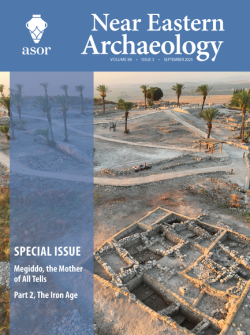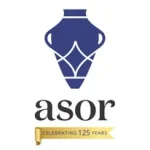
Table of Contents for Near Eastern Archaeology 88.3 (September 2025)
Pp. 176–185: “From Armageddon to Chicago: The Legacy of the University of Chicago’s Megiddo Expedition” by Kiersten Neumann
The Megiddo excavation of the University of Chicago’s Institute for the Study of Ancient Cultures (previously the Oriental Institute; hereafter ISAC) was the first of many multiyear archaeological expeditions initiated by the burgeoning institute in the early twentieth century. The discovery, recording, and interpretation that took place over the fourteen seasons of fieldwork (1925–1939) under three successive field directors—Clarence S. Fisher (1925–1927), P. L. O. Guy (1927–1934), and Gordon Loud (1935–1939)—would come to lay the foundations for archaeology in the southern Levant. Accessible through ISAC’s seminal publications, museum collections (including both archaeological objects and archival records), and public exhibitions, the wealth of information and materials acquired as a result of the Megiddo Expedition are still rigorously consulted and built upon today, making it one of the most impactful and lasting endeavors in ISAC’s history.
ASOR Members with online access: log into ASOR’s Online Portal here. Once logged in, click the JOURNALS tab in the top navigation bar. Tutorials for how to log in to the Online Portal as well as how to navigate to the Portal Journals page can be found here.
Pp. 186-193: “The Last Canaanites: Megiddo during the Iron Age I” by Eran Arie
This article explores the final stages of Canaanite Megiddo during Iron I, focusing on Strata VIB and VIA. Stratum VIB presents evidence for a modest village lacking monumental structures, while Stratum VIA marks the peak of urban development before its catastrophic destruction. The article argues for the architectural and social continuity between the Late Bronze and Iron Age I, highlighting Megiddo’s role as an independent citystate, and emphasizing its economic self-sufficiency, localized production, and Canaanite heritage. The destruction of Stratum VIA was unexpected, rapid, and complete, as there are no signs of crisis behavior.
ASOR Members with online access: log into ASOR’s Online Portal here. Once logged in, click the JOURNALS tab in the top navigation bar. Tutorials for how to log in to the Online Portal as well as how to navigate to the Portal Journals page can be found here.
Pp. 194-203: “Before the Omrides: The Early Days of Israelite Megiddo” by Assaf Kleiman and Israel Finkelstein
Excavations in the southeastern sector of Megiddo revealed important finds that illuminate the material culture and history of the site in particular and northern Israel in general during the early days of the Northern Kingdom (Israel). This includes the appearance of public architecture and the revival of the commercial networks in the eastern Mediterranean.
SIDEBAR P. 197: Sheshonq I (Biblical Shishak) at Megiddo, by Shirly Ben-Dor Evian
SIDEBAR P. 198: From Bronze to Iron, by Naama Yahalom-Mack
ASOR Members with online access: log into ASOR’s Online Portal here. Once logged in, click the JOURNALS tab in the top navigation bar. Tutorials for how to log in to the Online Portal as well as how to navigate to the Portal Journals page can be found here.
Pp. 204-211: “Megiddo of the Omride Dynasty” by Israel Finkelstein
This article deals with the remains of Stratum VA-IVB at Megiddo. From the perspective of relative chronology (i.e., ceramic typology), it dates to the late Iron IIA. Monuments belonging to this stratum, especially two ashlar-built palaces and the six-chambered gate, had previously been associated with the construction activities of King Solomon in the tenth century BCE. Traditional archaeology considerations and radiocarbon dating now put it in the first half of the ninth century—the period of the Omride dynasty of the Northern Kingdom (Israel). First, the history of research of Stratum VA-IVB is described, followed by the presentation of new evidence from the field on two of its monuments: Palace 6000, first excavated by Yigael Yadin, and the gate, unearthed by the University of Chicago team. Finally, general issues, such as the layout of the city and its cult, are discussed.
ASOR Members with online access: log into ASOR’s Online Portal here. Once logged in, click the JOURNALS tab in the top navigation bar. Tutorials for how to log in to the Online Portal as well as how to navigate to the Portal Journals page can be found here.
Pp. 212-220: “Horse Industry City: Eighth-Century BCE Megiddo” by Israel Finkelstein
The article deals with Stratum IVA at Megiddo, dated to the early Iron IIB, in the first half of the eighth century BCE. This layer yielded the biggest concentration of monuments in a city belonging to the Northern Kingdom. First, its construction and destruction dates are dealt with, and then the main monuments: the four-entry gate, water system, administration building with a sector devoted to cult, and the two systems of three-aisle longitudinal pillared building. The construction date and the function of the latter structures had been disputed. It is now clear that they belong to Stratum IVA and that they indeed served as stables, as first suggested in the 1920s. The number of units at Megiddo points to a developed industry, which probably specialized in breading horses and training them as war animals. This was among the most important economic ventures of the kingdom.
ASOR Members with online access: log into ASOR’s Online Portal here. Once logged in, click the JOURNALS tab in the top navigation bar. Tutorials for how to log in to the Online Portal as well as how to navigate to the Portal Journals page can be found here.
Pp. 222-230: “Megiddo in the Age of Empires: Assyria, Egypt, and Babylonia” by Assaf Kleiman
Following the collapse of the Northern Kingdom in the late eighth century BCE, Megiddo became the capital of the Neo-Assyrian province of Magiddû. The University of Chicago excavations exposed the settlement’s distinct orthogonal layout and administrative quarter. And yet, many questions concerning its chronology, material culture, and population remained unsolved. In this article, the unique contributions of recent fieldwork conducted in the mound’s northwestern sector to the understanding of Megiddo under Assyrian, Egyptian, and Babylonian rule are highlighted
ASOR Members with online access: log into ASOR’s Online Portal here. Once logged in, click the JOURNALS tab in the top navigation bar. Tutorials for how to log in to the Online Portal as well as how to navigate to the Portal Journals page can be found here.
Pp. 232-239: “Protecting and Presenting Armageddon: The Conservation and Public Interpretation of Tel Megiddo” by Shirly Ben-Dor Evian and Neil A. Silberman
The vital behind-the-scenes work of conservation and site presentation at Tel Megiddo is essential to preserving the site for visitation and raising public awareness about its archaeological and historical significance. Protecting the site’s extensive archaeological remains from deterioration requires ongoing conservation efforts at every scale from small finds to large excavation areas. And as Megiddo evolves from a strictly archaeological site to a cultural icon and tourism destination, the challenge of interpreting its monuments for diverse audiences has become more complex. This article explores Megiddo’s management history, conservation strategies, and interpretive approaches focused on deepening public understandings of Megiddo’s urban evolution and cultural significance.
ASOR Members with online access: log into ASOR’s Online Portal here. Once logged in, click the JOURNALS tab in the top navigation bar. Tutorials for how to log in to the Online Portal as well as how to navigate to the Portal Journals page can be found here.
Pp. 240-247: “The Contribution of the Megiddo Expedition to the Archaeology of the Levant and Beyond” by Israel Finkelstein and Matthew J. Adams
The article summarizes the results of three decades of excavations at Megiddo, emphasizing the initial goals of the Tel Aviv University Expedition and their fulfillment. It discusses the reinvestigation of main monuments uncovered in the past, and the main archaeological and historical contributions of the dig by period.
ASOR Members with online access: log into ASOR’s Online Portal here. Once logged in, click the JOURNALS tab in the top navigation bar. Tutorials for how to log in to the Online Portal as well as how to navigate to the Portal Journals page can be found here.









